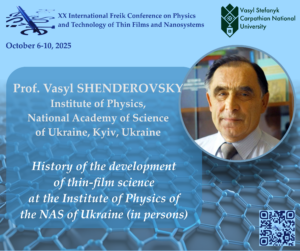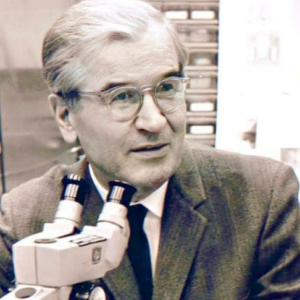*Special Section: History of Ukrainian Science: Unsung Names
As part of ICPTTFN–XX, we will host a special section spotlighting Ukrainian scholars whose groundbreaking contributions have been overlooked.
The section will feature an invited lecture by Prof. Vasyl Shenderovsky (physicist and historian of science; Doctor of Sciences, Professor), a widely recognized popularizer of Ukrainian scientific heritage and author of books and essays on outstanding Ukrainian scientists.

We will also present a short film dedicated to Oleksandr Smakula — an eminent Ukrainian-born physicist whose work decisively shaped modern optics and thin-film technology, directly resonating with the themes of our conference.
The exact time and date of this special session will be provided in the working program of the conference.
About Oleksandr (Alexander) Smakula (1900–1983, September 9 – 125th anniversary of the birth)

- Pioneer of anti-reflection (AR) coatings. While working at Carl Zeiss (Jena), Smakula invented and patented the first practical interference-based AR coating for optical glass in 1935 (German patent DE-PS 685 767, issued 1 November 1935). This breakthrough drastically reduced surface reflections and became foundational for modern thin-film optics. Вікіпедіяlenspire.zeiss.com
- Impact and historical context. Early AR-coating methods at Zeiss were kept as a military secret for several years and were only widely disseminated after World War II. ZEISS later branded the technology in its T* coating lineage; contemporary ZEISS histories credit Smakula’s coating with markedly improving image transmission (e.g., on binoculars). opticaorgdev.blob.core.windows.netblogs.zeiss.com
- Academic career. After the war, Smakula moved to the United States; by 1951 he joined the Massachusetts Institute of Technology (MIT), where he pursued research on crystalline materials. He died in Auburn, Massachusetts in 1983.
Why this matters for ICPTTFN–XX. Smakula’s AR coatings are a classic and enduring example of thin-film engineering driven by optical-interference design — a core topic for our community. Their principles underpin today’s multilayer coatings for cameras, lasers, photovoltaics, and advanced optoelectronics.
*The exact time and date of the special lecture will be provided in the working program of the conference.
